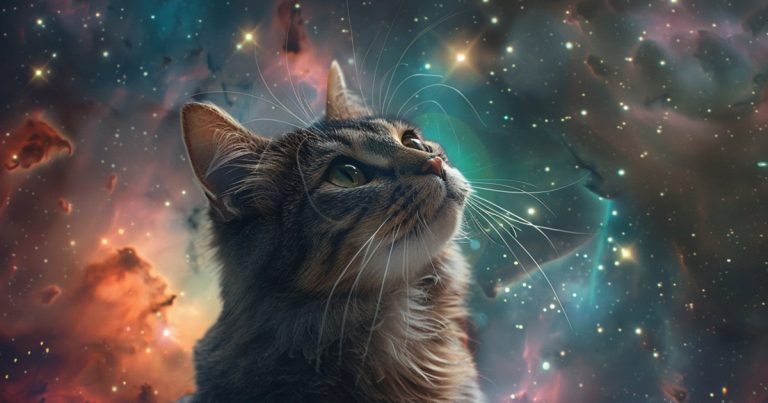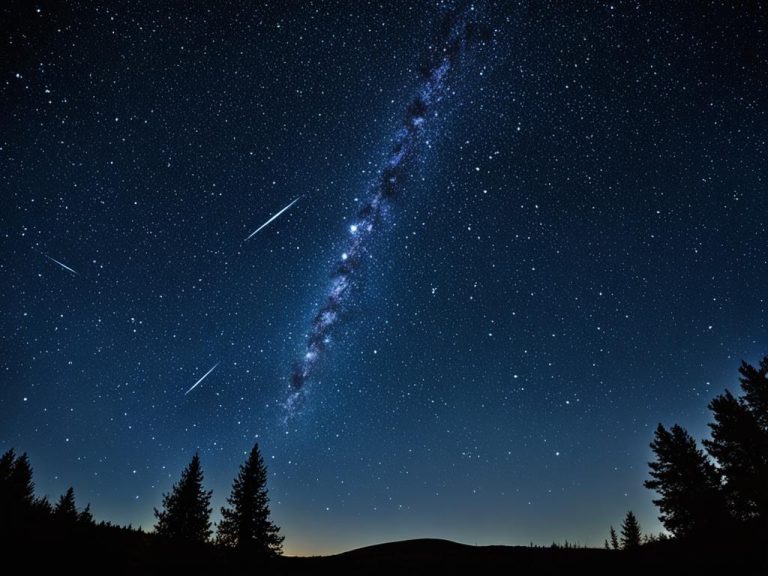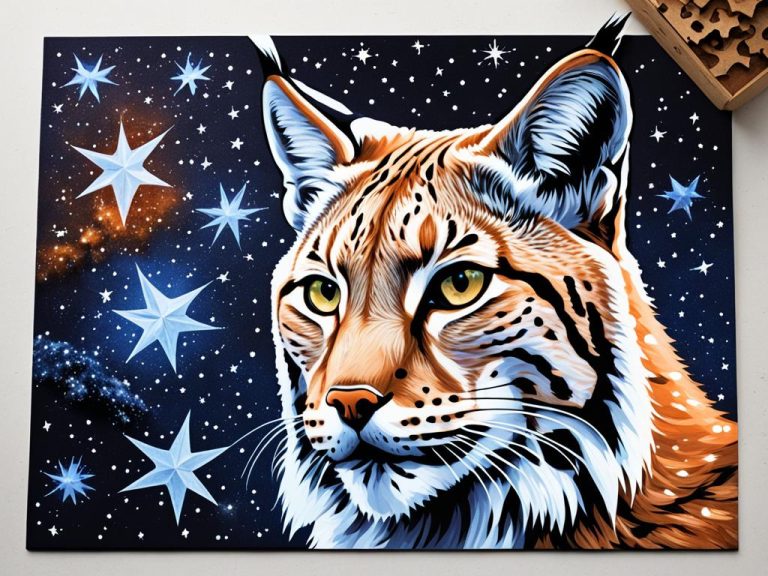Explore the Mysteries of Lynx Constellation
Modified: July 21, 2024 Author: International Star Registry
Did you know that Lynx constellation is faint but full of deep-sky objects? It has fascinated astronomers and stargazers for ages. It’s in the northern sky, near Ursa Major and Ursa Minor.
Lynx is also called the Lynx star cluster or the celestial lynx. It’s a treasure for amateur astronomers. Its subtlety hides secrets that still intrigue sky watchers. Lynx brings mythology and science together, showing the beauty of the universe.

Key Takeaways:
- The Lynx constellation is a lesser-known grouping of stars in the northern celestial hemisphere
- Despite its faint appearance, Lynx is home to intriguing deep-sky objects
- Lynx is bordered by notable constellations such as Ursa Major and Ursa Minor
- The Lynx constellation offers a unique opportunity for amateur astronomers to explore the wonders of the universe
- From mythological stories to its astronomical significance, Lynx holds a wealth of mysteries to be unraveled
Unraveling the History and Mythology
The Lynx constellation is linked to the elusive and sly lynx. This wild cat with great senses is known to be quiet and stay alone. It mesmerized people from all over the world in ancient times.
A Greek myth tells us Artemis, the goddess, turned a lynx into a star group. She did this to honor its sharp hunting skills. This story makes the Lynx constellation even more intriguing and mystical, urging us to learn more about it.
In the past, people saw stars and constellations as gods with their own tales. The Lynx constellation, due to its stories, has always been a key figure. It inspired everyone who gazed at the night sky.
Exploring Mythological Representations
The Lynx constellation’s stories are found in many cultures. In Norse tales, it was tied to Freyja, the goddess of love and beauty. The ancient Egyptians saw it as the sun god Ra’s boat, sailing through the sky.
Generations have shared myths about the lynx in the stars. These tales deepened the bond between ancient people and the Lynx constellation’s celestial charm.
The myths remind us of our ancestors’ fascination with the night sky. This connection tells stories of the universe’s hidden powers and wonders.
Star Patterns and Astronomical Significance
The Lynx constellation has unique star patterns in the night sky. It’s not very famous, but it’s full of hidden treasures to see.
Lynx is special because it has deep-sky objects to explore. NGC 2419, also called the “Intergalactic Wanderer,” is one. It’s a globular cluster more than 300,000 light-years from Earth, a true marvel of the Lynx constellation.
There’s also the UFO Galaxy, NGC 2683, in Lynx. It looks like a flying object from the side. These galaxies show how big and varied our universe is.
Finding Lynx in the Night Sky
To spot the Lynx constellation, use a star map. It’s in the northern sky, between Ursa Major, Ursa Minor, and Camelopardalis. It can be hard to see if the sky isn’t dark and clear. Yet, once you find it, it’s amazing to look at.
Are you excited to find Lynx in the sky? A star map focusing on Lynx’s position will be very helpful. The map shows you where stars and constellations are at night. So, finding Lynx won’t be as hard with a star map in hand.

Exploring Lynx’s position relative to neighboring constellations:
- Ursa Major: Lynx is to the south of Ursa Major, between the Big Dipper’s foreleg and the celestial hunter.
- Ursa Minor: It appears northeast of Ursa Minor, making the northern sky even more beautiful.
- Camelopardalis: Lynx is to the northwest of Camelopardalis, adding mystery and charm to the area.
When looking for Lynx, remember to be patient and find a dark spot away from lights. Let your eyes adjust to the dark and focus on the sky’s subtle star patterns. This will help you spot Lynx in the vast universe.
Naming a Star in the Lynx Constellation
Naming a star in the constellation Lynx is a unique idea for star lovers. With International Star Registry, you can name a star after someone special. This makes a great gift for any occasion, from birthdays to anniversaries.
The Perfect Gift for any Occasion
Naming a star in the Lynx constellation through International Star Registry is ideal for all occasions. It’s perfect for birthdays, anniversaries, graduations, or just to show you care. Buying a star is a unique, thoughtful gift that leaves a lasting impression.
Picture their joy when they open a package that has a star certificate and a celestial map. This shows the star’s exact location in the Lynx constellation. It’s an unforgettable gift that stays in their heart and the sky.
Buying a star is easy on International Star Registry’s website at starregistry.com. Pick a star package, fill in the details, and buy. In just a few clicks, you’ve given a gift beyond Earth.
For special occasions or just because, a named star in the Lynx constellation is unique. It’s a memorable way to show you care. This lasting gift reminds them of your love and thoughtfulness.
Celebrities and the Lynx Constellation
The Lynx constellation has amazed not only scientists but also stars from different areas. Celebs like Jennifer Lawrence and Paul Anka have stars named after them there. This makes the Lynx even more special.
Lynx’s unique stars and importance in astronomy catch both pros and fans’ eyes. Even stars love this constellation, as shown by celebrities with stars named after them.
Kathleen Robertson got a star name in Lynx on November 24, 2005. You know her from hits like “Beverly Hills, 90210.” Find out more here.

With Lynx’s star-studded sky, naming them is a unique gesture. Consider naming a star after someone special. International Star Registry offers this service.
Love the mystery of the Lynx? Or thinking of a stellar gift? Discover the Lynx and its stars named after famous folks. It’s full of chances to make lasting memories.
Unlocking the Mysteries of Lynx Constellation
The Lynx constellation isn’t as bright as others, but it draws people in with its mystery. Exploring Lynx takes you on a journey full of wonder and secrets. It’s a chance to dive into the mysteries of the universe and feel amazement.
Lynx Constellation Facts
- The Lynx constellation is located in the northern sky, nestled between Ursa Major and Auriga.
- Its name is derived from the Latin word “lynx,” meaning “wildcat.”
- Although faint, Lynx features several mesmerizing deep-sky objects, including dazzling star clusters and distant galaxies.
- Among its notable celestial wonders is the NGC 2419 globular cluster, affectionately known as the “Intergalactic Wanderer.”
Lynx Constellation Mysteries
The Lynx constellation might look small, but it’s full of interesting mysteries. People who love space are intrigued by its dark spots, unique star formations, and unknown areas. Learning about Lynx raises many questions that push astronomers to explore more of space.
Lynx Constellation Exploration
Exploring the Lynx constellation opens up a world of amazing sights. Understanding Lynx helps us see how huge and interesting our Universe is. Starting a journey through Lynx’s stars can make you love the mysteries of space forever.
The Beauty and Mystique of Lynx Constellation
The Lynx constellation looks quiet, but its beauty is amazing. It has patterns that have wowed people for a long time. The Lynx catches the eyes and dreams of anyone who looks.
This group of stars is tied to old stories and big meanings. Long ago, people thought of Lynx like the wildcat. This made the stars seem full of power.
For serious astronomers, astrosoftware.com is a great place. It has full reports on the stars in Lynx. This gives detailed info on celestial bodies.
The Lynx cat is as enchanting as its night-sky namesake. Cats like the Lynx point have bright blue eyes. Their fur is a special kind.
Looking at Lynx stars or having a Lynx cat by your side is like magic. Stop and enjoy the universe around us. See the beauty in both the sky and the earth.
Embracing the Wonder of the Cosmos
The Lynx constellation invites you to look up. It shows how everything is connected. This makes you think about your role in the universe.
The Lynx is full of cosmic beauty. It makes you wonder about the stars. People have noticed Lynx for a long time.
Looking into space shows endless possibilities. It makes you feel small but also part of something big. This is true for anyone who loves looking at the stars.
The stars in Lynx make amazing shapes. Scientists have learned a lot from these patterns over time.
Make Memories That Shine Brightly
With International Star Registry, you can make memories that last forever. Imagine a gift that marks a special moment or shows your love for someone. By naming a star in the Lynx constellation, you leave a lasting impact and see the beauty of space.
Naming a star gives a gift that’s special. It’s perfect for births, weddings, or remembering those who are gone. A Lynx star shows love, joy, and memories.
Go to International Star Registry now for a unique experience. Pick a star in Lynx and be part of its story forever.
- Experience the awe-inspiring beauty of the night sky
- Create a personalized and meaningful gift
- Celebrate life’s special moments in a truly unforgettable way
- Leave a lasting legacy for future generations
For more about Lynx, night sky highlights in February 2024, and the 88 constellations, look here:
- Constellations of Words – Discover fascinating facts about the Lynx constellation and its rich mythology.
- Royal Museums Greenwich – Learn about the night sky highlights in February 2024 and what celestial events to look out for.
- AstroTelescopium – Explore a beginner’s guide to the 88 constellations and unlock the mysteries of the night sky.
Conclusion
The Lynx constellation is hard to see, but full of beauty and mystery. It has a lot of stories in history and helps us learn about space. People who love stars and space find it very interesting.
Do you want to make a star your own in the Lynx constellation? International Star Registry can help. You can buy a star for someone’s special day. This makes a truly unique gift.
When you name a star, you get a special certificate and map. Plus, you help support science and learning. Your star can be seen and remembered by many, making it very special.
FAQ
What is the Lynx constellation?
The Lynx constellation is a group of stars in the sky’s north part.
What is the mythology behind the Lynx constellation?
In Greek tales, a wild cat with amazing hunting skills was turned into the Lynx constellation by Artemis.
What are some notable deep-sky objects in the Lynx constellation?
This area has neat things like the “Intergalactic Wanderer” and the “UFO Galaxy.”
Can I name a star in the Lynx constellation?
Yes, go to International Star Registry to give a star in Lynx a name.
Is naming a star in the Lynx constellation a good gift idea?
Naming a Lynx star is special and it marks big events with a lasting memory.
Are there any celebrities who have named stars in the Lynx constellation?
Famous people like Jennifer Lawrence, Paul Anka, and Candice Bergen have stars here.
Source Links
- Explore the Night Sky: A Beginner’s Guide to the 88 Constellations – https://astrotelescopium.com/blogs/news/unlocking-the-mysteries-of-the-night-sky-a-beginners-guide-to-the-88-constellations
- Prints of Lynx constellation – https://www.mediastorehouse.com/science-photo-library/history/lynx-constellation-1700531.html
